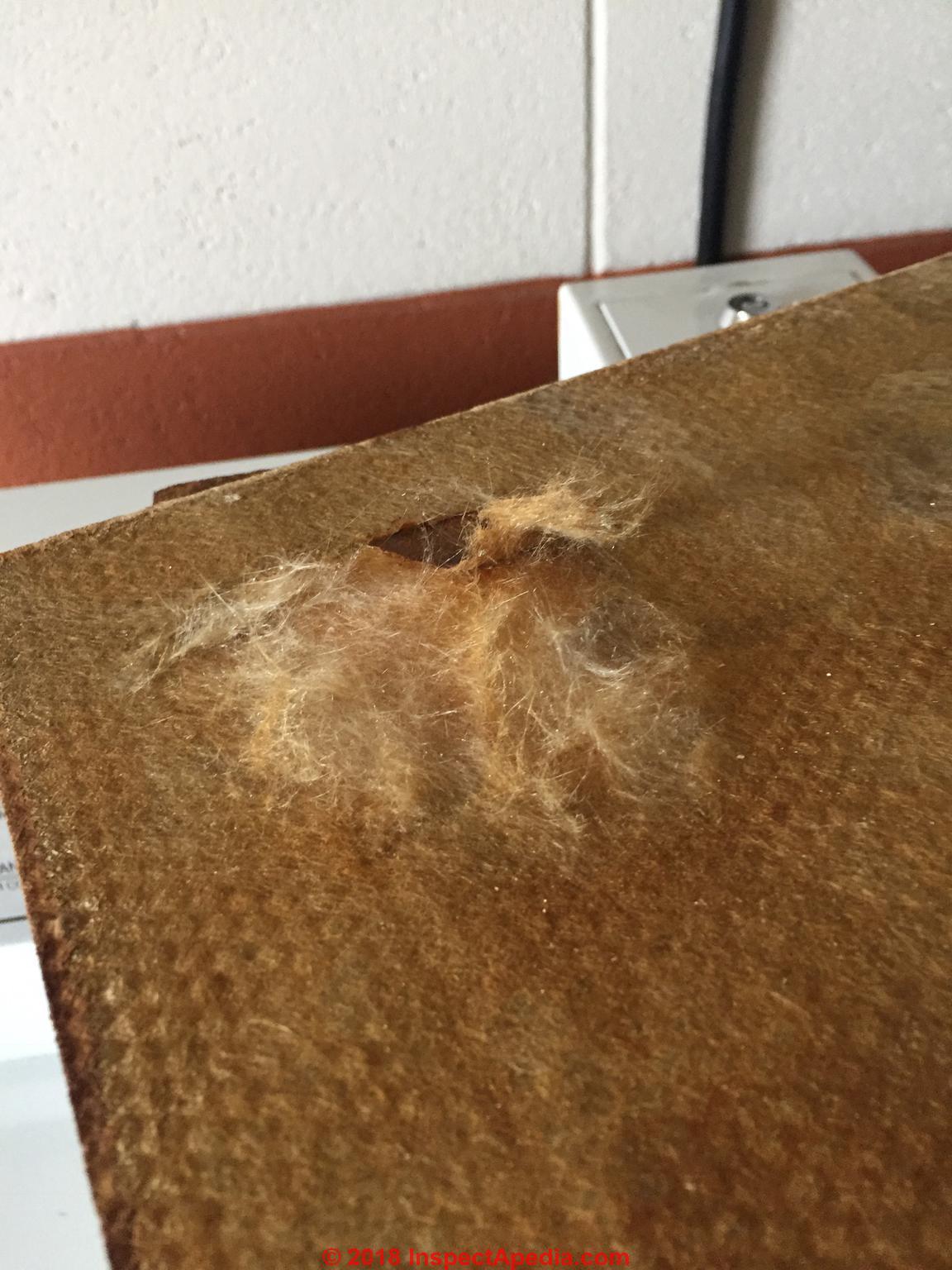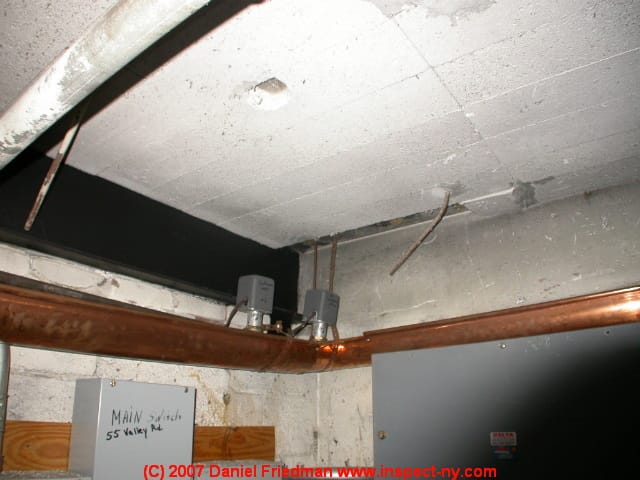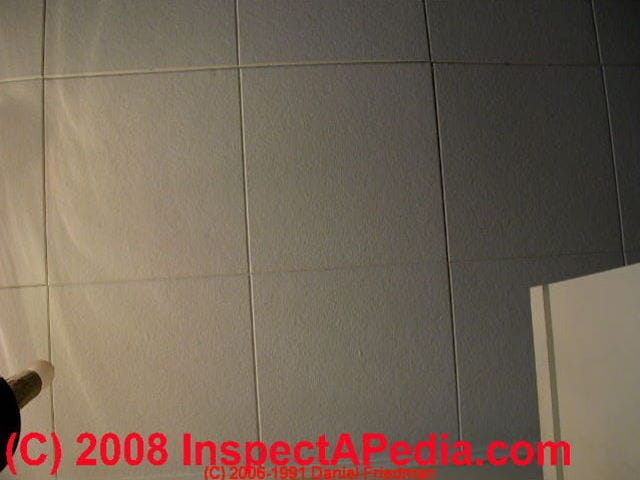 Asbestos Ceiling Tile Identification
Asbestos Ceiling Tile Identification
5 easy steps to tell if ceiling tiles contain asbestos
- POST a QUESTION or COMMENT about how to identify ceiling tiles that contain asbestos
Some ceiling tiles made before the late 1980s contain asbestos, a hazardous substance if the ceiling is damaged or if it is disturbed by demolition.
Here we explain how to make a reasonable guess at whether or not your ceiling tiles contain asbestos, and at the same time we emphasize that there's no reason to panic.
Asbestos is safe and legal to remain in homes or public buildings as long as the asbestos materials are in good condition and the asbestos can not be released into the air. - US EPA & Other Sources
But you should take care not to create a dusty mess, and to avoid unnecessary expense and health risks caused by removing ceilings unnecessarily.
We also include photos of ceiling tiles that can easily be identified as not containing asbestos, and we describe how to safely collect a ceiling tile sample for asbestos test lab analysis.
InspectAPedia tolerates no conflicts of interest. We have no relationship with advertisers, products, or services discussed at this website.
- Daniel Friedman, Publisher/Editor/Author - See WHO ARE WE?
5 easy steps to make a guess at asbestos hazard from unknown ceiling tiles
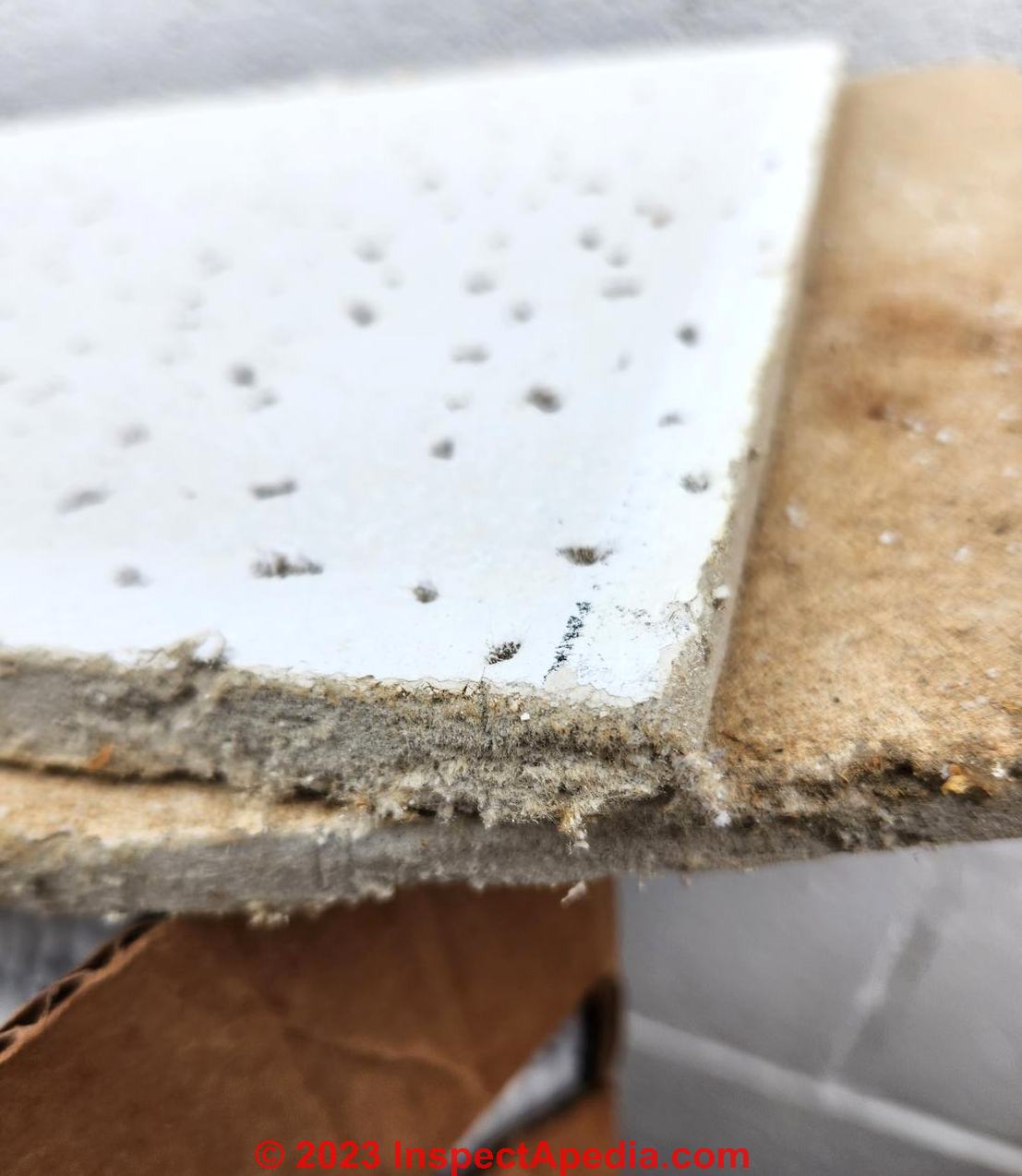 When Was Asbestos Used in Ceiling Tiles?
When Was Asbestos Used in Ceiling Tiles?
In the U.S. some but not all ceiling tiles contained asbestos as late as those made in 1989.
Asbestos was used in the some (not all) ceiling tile tiles and in drop-in tiles in suspended ceilings in the tile body or in paper facing or backing on the ceiling tiles; asbestos was also a common ingredient in some mastic adhesives used for glue-up application of ceiling tiles.
5 steps that you can take to determine the chance your own ceiling tiles contain asbestos are given below on this page.
Asbestos ceiling tile risk level?
For ceilings that are undamaged and are not to be disturbed such as by demolition, sawing, chopping, etc, there is no meaningful asbestos hazard to building occupants.
That's because asbestos-containing ceiling tiles are not considered friable - not easily made into dust.
But such tiles are nevertheless soft enough that unnecessary sampling or disturbance could release asbestos dust and particles.
In addition, some ceiling tiles such as used in suspended ceilings (drop ceilings) in older buildings often hold a collection of dust and debris (from other sources) on the hidden upper side of the tile. So don't disturb your ceiling enough to create a dusty mess.
We've inspected roughly 4000 buildings for visually-obvious asbestos materials including ceiling tiles. Where justified we recommended testing of some of those ceilings for asbestos. But often you can make an intelligent first-guess at the asbestos question from just the steps below and in some cases you can immediately rule-out asbestos.
5 Steps to Check your Ceiling Tiles for Asbestos
- VISUAL INSPECTION of YOUR CEILING TILES - can rule in or out possible asbestos
- LOOK FOR CEILING TILE MANUFACTURER'S STAMPS or CODES
- CHECK THE BUILDING AGE
- CHECK THE CEILING AGE
- PREPARE A CEILING TILE SAMPLE for ASBESTOS TESTING
We include photos of asbestos-suspect and some examples of asbestos-free ceiling tiles in the article below.
Step 1: Look at the ceiling tile material, particularly its edges and back surface
A view of the edges or back of the ceiling tile are particularly helpful in ruling in or out asbestos, but don't create a dusty mess just to get a look.
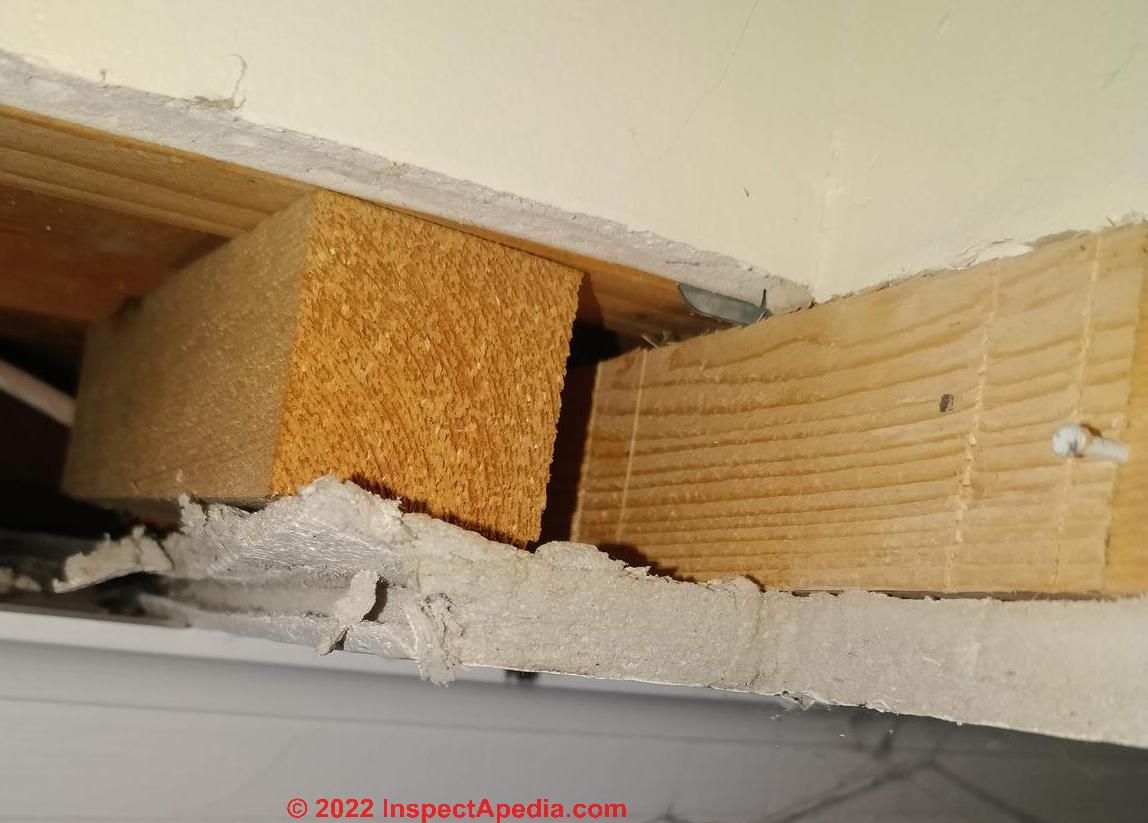
Signs that the ceiling tile may contain asbestos
If an edge-view of your ceiling tiles is grey-white or simply gray like the photo above, they could contain asbestos - though not always. Other gray ceiling tiles are simply paper-based. For tiles like those in this photo, I'd recommend having a sample tested.
Signs that the ceiling tile is not at all likely to contain asbestos
On the other hand, by mere visual inspection, it is possible to identify some materials that are definitely not asbestos.
Example: ceiling tiles or suspended ceiling drop-in panels made of fiberglass are easy to identify simply by visual inspection. Notice the yellow or tan fine, coarse fibers in the photos below.
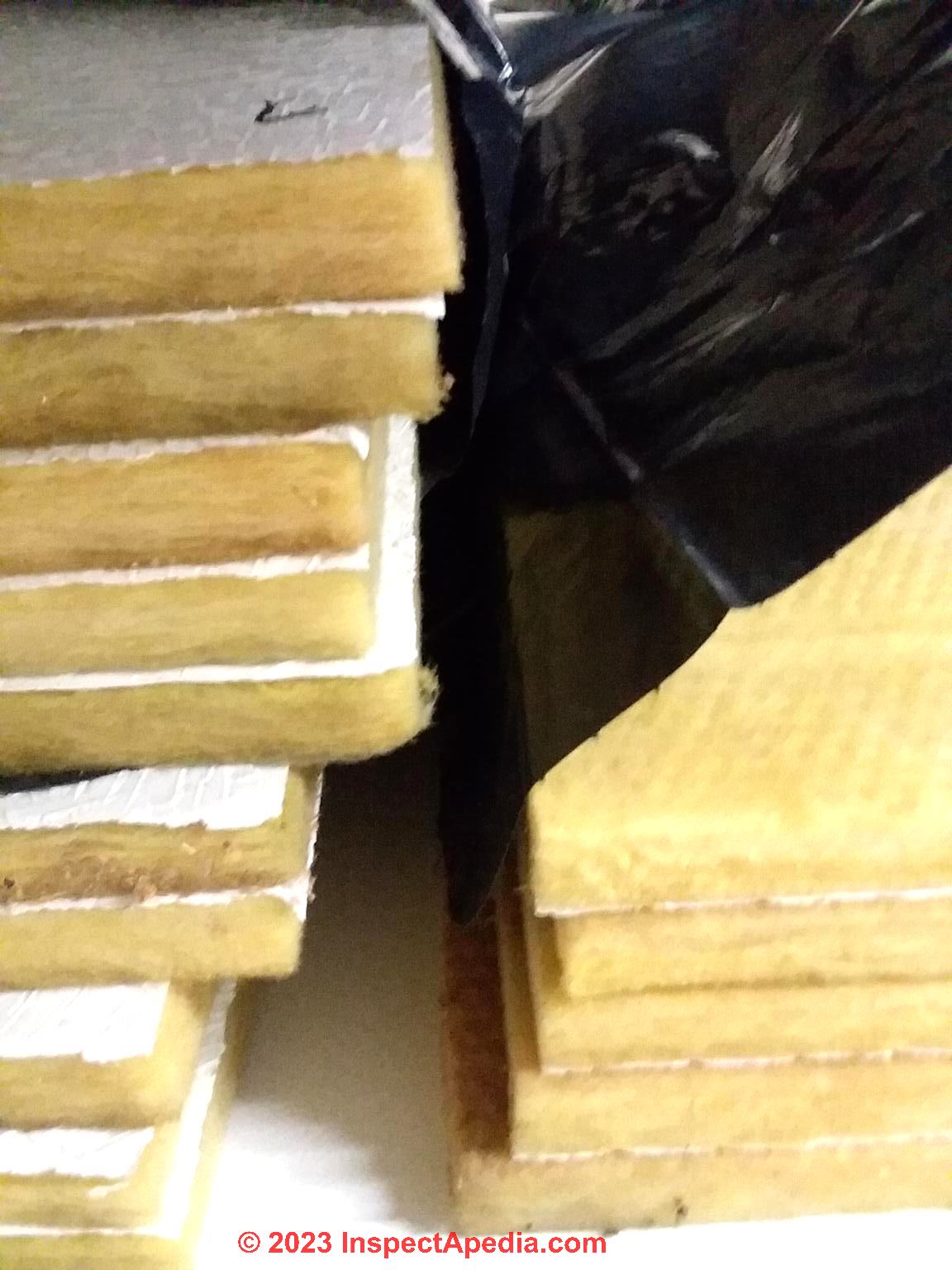 ...
...
Fiberglass, like that in our photos above and below is not an asbestos product. If your ceiling tile is homogeneous fiberglass it is not at all likely to contain asbestos unless by cross-contamination from another asbestos source.
More examples of asbestos-free ceiling materials are at
PHOTOS of ASBESTOS-FREE CEILING TILES
Step 2: look for manufacturer's stamps or data on the ceiling tile or its packaging
Look for any evidence of the manufacturer's name: a stamp on the back of a tile, packaging left-over, records of the installation.
Often one can infer the date of manufacture of a product by ancillary stamps or statements such as compliance with laws or standards whose initial date is known.
More detailed help is at
ASBESTOS CEILING TILE MANUFACTURERS
If you can identify the manufacturer of your ceiling tiles, also see this list of
ASBESTOS PRODUCING COMPANIES & TRUSTS
Some Manufacturers specifically say their ceiling tiles never contained asbestos
If the ceiling is made by one of the manufacturers who assert their products never contained asbestos or who give specific dates after which production of asbestos-containing ceiling tiles ceased that can answer the asbestos question for your home.
Step 3: Check the Age of Building - is it newer than when asbestos was in use?
Next consider the age of the home as a floor under the maximum age of the ceiling. If the building age is newer than the last date of use of asbestos in your country that can provide a credible "no asbestos" conclusion for the material in question.
For the U.S. that's 1989.
For the last-sale date for asbestos in other countries, see
HISTORY & DATES OF ASBESTOS CONTAINING MATERIAL BANS & REGULATIONS
Step 4: Check the Age of the Ceiling Tile Installation Itself
Next consider the age of the ceiling, e.g. dates or records of renovations - for the same reason given in the question above.
Date threshold: If the ceiling was installed in the U.S. after the mid-1980's and more certainly after 1989, it's not at all likely to contain asbestos.
In other countries, the last date at which asbestos products including asbestos ceiling tiles were sold will differ.
For more detail
see
ASBESTOS CEILING HISTORY / DATES
and also
ASBESTOS MATERIAL REGULATIONS - where we provide asbestos last used, last sold or last imported dates for most countries.
Keep in mind that a ceiling installed shortly after that production date could still contain asbestos if new old stock asbestos-containing ceiling tiles were used.
Step 5: Test the Ceiling Tile for Asbestos
If you know nothing about the ceiling and can not remove it without making a dusty (and potentially hazardous) mess, then you may want to have a sample tested.
If you have extra ceiling tiles that were not installed, collect your sample from one of those.
If you have to remove part or all of installed ceiling tiles,
see
See
ASBESTOS TESTING LAB LIST - certified asbestos testing labs
Watch out: when collecting a sample of ceiling tile for asbestos testing, you should be sure to collect the full thickness of the tile, as asbestos may have been used in only the ceiling tile core, or in some products, as a layer of asbestos paper on a surface.
Watch out: use a sharp utility knife or "box knife" to make a thin clean cut in a ceiling tile to be tested, or send an entire intact ceiling tile to your lab. Do not break the tile and don't try cutting it with a saw - we want to avoid unnecessary dust creation.
Make your cut over spread newspaper, then when your sample is complete and has been bagged in a zip-lok type clear plastic bag for labeling, fold up the newspaper for disposal. Use damp wiping and HEPA vacuuming to clean up any dust.
Forms of Asbestos used in Ceiling Tiles
If your lab test finds that asbestos was used in your ceiling tiles, usually it's a small percent of the total ceiling tile volume, and it will be one of the following forms:
Amosite asbestos, a widely used form of asbestos, was used in some ceiling tiles as well as in roof and floor tiles.
Chrysotile asbestos, one of the most commonly used asbestos fibers, was used in production of some ceiling materials.
Crocidolite asbestos was also used in ceiling tile production.
Tremolite asbestos (shown above): ceilings in areas where fire risk was a particular concern were sometimes covered with nearly pure tremolite asbestos board or, alternatively by cement-asbestos products. You'll find these as a fire barrier in boiler rooms and similar locations..
Our photo shows tremolite asbestos panels glued to the ceiling over a basement of a commercial building in White Plains, New York.
Dates of Ceiling Tiles: age, appearance, types, materials, manufacturers help ID use of Asbestos
This discussion has moved
to ASBESTOS CEILING HISTORY / DATES
Which ceiling tile brands are reported to have contained asbestos? Which ceiling tiles are asbestos free?
This topic moved
to ASBESTOS CEILING TILE MANUFACTURERS
This article series assists building buyers, owners or inspectors who need to identify asbestos materials (or probable-asbestos) in buildings by simple visual inspection.
...
...
Continue reading at ASBESTOS-FREE CEILING TILES, or select a topic from the closely-related articles below, or see the complete ARTICLE INDEX.
Or see ASBESTOS CEILING TILE FAQs - questions and answers posted originally at the bottom of this page.
Or see these
Recommended Articles
- ASBESTOS CEILING TILE IDENTIFICATION - 5 Easy Steps to tell if CEILING TILES are likely to contain asbestos -
- ASBESTOS-FREE CEILING TILES
- ASBESTOS CEILING TILE ID REQUESTS
- ASBESTOS CEILING TILE REMOVAL PROCEDURES
- ASBESTOS-SUSPECT CEILING COVEROVER
- ASBESTOS TESTING LAB LIST - certified asbestos testing labs
- CEILING TILE HISTORY / DATES - asbestos ceiling tile history & Dates
- CEILING TILE MANUFACTURERS - list of asbestos ceiling tile brands & how to identify them
- CEILING TILE INGREDIENTS
- CEILING TILE REMOVAL PROCEDURES
- CEILINGS, DROP or SUSPENDED PANEL
- CEILING FINISHES INTERIOR
- CEILING PAINT TEXTURED / POPCORN ASBESTOS
- CEILINGS, DROP or SUSPENDED PANEL
- FIBERGLASS ASBESTOS COMBINATIONS
- HAZARD vs RISK - what's the difference, why you should care
- HISTORY & DATES OF ASBESTOS CONTAINING MATERIAL BANS & REGULATIONS
- In addition to citations & references found in this article, see the research citations given at the end of the related articles found at our suggested
CONTINUE READING or RECOMMENDED ARTICLES.
Suggested citation for this web page
ASBESTOS CEILING TILE IDENTIFICATION at InspectApedia.com - online encyclopedia of building & environmental inspection, testing, diagnosis, repair, & problem prevention advice.
Or see this
INDEX to RELATED ARTICLES: ARTICLE INDEX to ASBESTOS HAZARDS
Or use the SEARCH BOX found below to Ask a Question or Search InspectApedia
Ask a Question or Search InspectApedia
Try the search box just below, or if you prefer, post a question or comment in the Comments box below and we will respond promptly.
Search the InspectApedia website
Note: appearance of your Comment below may be delayed: if your comment contains an image, photograph, web link, or text that looks to the software as if it might be a web link, your posting will appear after it has been approved by a moderator. Apologies for the delay.
Only one image can be added per comment but you can post as many comments, and therefore images, as you like.
You will not receive a notification when a response to your question has been posted.
Please bookmark this page to make it easy for you to check back for our response.
IF above you see "Comment Form is loading comments..." then COMMENT BOX - countable.ca / bawkbox.com IS NOT WORKING.
In any case you are welcome to send an email directly to us at InspectApedia.com at editor@inspectApedia.com
We'll reply to you directly. Please help us help you by noting, in your email, the URL of the InspectApedia page where you wanted to comment.
Citations & References
In addition to any citations in the article above, a full list is available on request.
- 3/07: special thanks to Gary Randolph, Ounce of Prevention Home Inspection, LLC Buffalo, NY, for attentive reading and editing suggestions. Mr. Randolph can be reached in Buffalo, NY, at (716) 636-3865 or email: gary@ouncehome.com
- EPA ASBESTOS MATERIALS BAN: CLARIFICATION 1999
- EPA Guidance for Controlling Asbestos-Containing Materials in buildings, NIAST, National Institute on Abatement Sciences & Technology, [republishing EPA public documents] 1985 ed., Exposure Evaluation Division, Office of Toxic Substances, Office of Pesticides and Toxic Substances, U.S. Environmental Protection Agency, Washington,D.C. 20460
- Thermafiber, Inc. (now a division of Owens Corning®) at Thermafiber, Inc., 3711 Mill Street, Wabash, IN 46992, Tel: 888-834-2371 (U.S. & Canada) - 260-563-2111 Website: www.thermafiber.com or Thermafiber technical services at 888-834-2371 (U.S. & Canada) ; Phone: 260-569-0801, Fax: 260-563-8979 or Email: technicalservice@owenscorning.com
- [1] Celotex 1973 Celotex Acoustical Systems catalog, January 1973
Celotex ceiling products division was purchased by Ceiling Products & Gypsum Wallboard (BPB) of the U.K. beginning in 1999
- [2] Celotex Home Building Materials, 1947 catalog, lists: Cane fiber products: Celotex sheathing, Celotex insulating lath (board), Celotex interior finish, Celo-Siding, Celo-Rok Gypsum products [may contain asbestos]: Celo-Rok anchor lath, Celo-Rock wallboards, Celo-Rok plasters, and Other Products: Celotex rock wool, Celotex roofing, Celotex hard boards, Celotex Cemesta, Celotex Corporation, Chicago IL
- [3] Celotex Insulating Cane Board, product catalog
- [4] Celotex Building Insulating Materials, 1948 Catalog, listing: Cemesto insulation, Cemesto roof decks, Cemesto exterior wall coverings, Cemesto interior wall coverings [we believe the Cemesto lines refer to cement-asbestos products - ed. ]
- [5] Celotex Sound Conditioning, 1948 Catalog, including perforated asbestos board sheets
- [6] Certainteed Ceilings, Adagio fiberglass/mineral fiber composite acoustical ceiling product MSDS, web search 11/22/2011, original source: certainteed.com/resources/Adagio_MSDS_2010.pdf
- [7] "Board of Education for the School District of the City of Detroit v. Celotex, et al., Circuit Court of Wayne County, Michigan, No. 84-429634-ND"
- [8] Armstrong Corporation, web search 6/22/12, original source: http://www.armstrong.rs/commclgeu/eu1/uk/rs/FAQ_other.html, [Copy on file as Armstrong_Ceil_Asbestos.pdf]
- [9] Lipsitz & Ponterio, LLC, "Carpenters and Mesothelioma", Lipsitz & Ponterio, LLC, 135 Delaware Ave, 5th Floor, Buffalo, NY 14202-2415 (716) 849-0701. Web search 6/22/12, original source: http://www.mesotheliomacarpenter.com/carpenters-asbestos-exposure/ceiling-tile/ [Copy on file as LiIpsitz_Asbestos.pdf]
- [11] Celotex [UK] History, Celotex Insulation Specialists, web search 6/30/12, original source: http://www.celotex.co.uk/celotex-history [Copy on file as Celotex_History_UK.pdf ]
- [14] Armstrong Corporation, "Corporate History: a Historical Summary", web search 6/30/12, original source: https://www.armstrongflooring.com/corporate/corporate-history.html
- [16] Steven Mlynarek, Morton Corn, Charles Blake, "Asbestos Exposure of Building Maintenance Personnel", Regulatory Toxicology and Pharmacology, 23, 213–224 (1996) ARTICLE NO. 0045, http://library.certh.gr/libfiles/PDF/GEN-PAPYR-4810-ASBESTOS-by-MLYNAREK
-in-RTAP-VOL-23-ISS-3-PP-213-224-Y-1996.pdf - [17] National Institute of Occupational Safety and Health (NIOSH) (1989). In NIOSH Manual of Analytical Methods (P. M. Eller, Ed.), Method 7400. NIOSH, Washington, DC.
- [18] U.S. Environmental Protection Agency (USEPA—Green Book) (1990). In Managing Asbestos in Place: A Building Owners Guide to Operations and Maintenance Programs for Asbestos-Containing
- [19] U.S. Department of Labor, Occupational Safety and Health Administration (USDOL) (1994). In Occupational Exposure to Asbestos: Final Rule, FR Vol. 59, No. 153:40964–41162. Materials, Report 2OT-2003. USEPA, Washington, DC.
- [20] U.S. Department of Labor, Occupational Safety and Health Administration
(USDOL) (1986). In Occupational Exposure to Asbestos: Tremolite, Anthophyllite, and Actinolite: Final Rule, FR Vol. 51, No. 119:22631–22644. - [21] U.S. Environmental Protection Agency (USEPA) (1990). In Environmental Asbestos Assessment Manual, Superfund Method for the Determination of Asbestos in Ambient Air, Part 2, Technical Background Document, Report EPA/540/2-90/005 b. USEPA, Washington, DC
- [22] Armstrong Ceiling - Frequently Asked Questions, Armstrong Corporation, web search 6/30/12, original source: https://www.armstrongflooring.com/resclgam/na/ceilings/en/us/article17697.html
- [23] BPB America Inc., 5301 West Cypress St., Suite 300, Tampa, FL 33607, Tel: 866-427-2872 E-mail: crc@bpb-na.com Web: www.bpb-na.com. Acoustic ceiling tile & accessories.
- [24] Affa Tile Company No. 1116/8, Poonamalee High Road, Opposite Hotel Shan Royal, Koyambedu Chennai, Tamil Nadu - 600 107, India, E-Mail: affatiles@gmail.com website: http://www.affatiles.com Tel:044-24757498, 044 - 24757497
- [25] Made-in-China.com, online sevice to connect buyers with product suppliers in China, web search 6/30/12
- [26] "Directive 2003/18/EC of the European Parliament and of the Council of 27 March 2003 amending Council Directive 83/477/EEC on the protection of workers from the risks related to exposure to asbestos at work". Publications Office of the European Union. 27 March 2003 Web search 6/30/12, original source: http://eur-lex.europa.eu/LexUriServ/LexUriServ.do?uri=CELEX:32003L0018:EN:NOT
- [27] H. M. Murray, testimony before the Departmental Committee on Compensation for Industrial Diseases "Minutes of Evidence, Appendices and Index", 1907. p. 127
- [28] D. Auribault, "Note sur l'Hygiène et la Sécurité des Ouvriers dans les Filatures et Tissages d'Amianté (On hygiene and security of the workers in the spinning and weaving of asbestos)" in Le Bulletin de l'Inspection du Travail, 1906, pp 120–132.
- [29] Wikipedia entry on Asbestos and various citations from that article, web search 6/30/12, original source: en.wikipedia.org "Asbestos"
- In addition to citations & references found in this article, see the research citations given at the end of the related articles found at our suggested
CONTINUE READING or RECOMMENDED ARTICLES.
- Carson, Dunlop & Associates Ltd., 120 Carlton Street Suite 407, Toronto ON M5A 4K2. Tel: (416) 964-9415 1-800-268-7070 Email: info@carsondunlop.com. Alan Carson is a past president of ASHI, the American Society of Home Inspectors.
Thanks to Alan Carson and Bob Dunlop, for permission for InspectAPedia to use text excerpts from The HOME REFERENCE BOOK - the Encyclopedia of Homes and to use illustrations from The ILLUSTRATED HOME .
Carson Dunlop Associates provides extensive home inspection education and report writing material. In gratitude we provide links to tsome Carson Dunlop Associates products and services.


